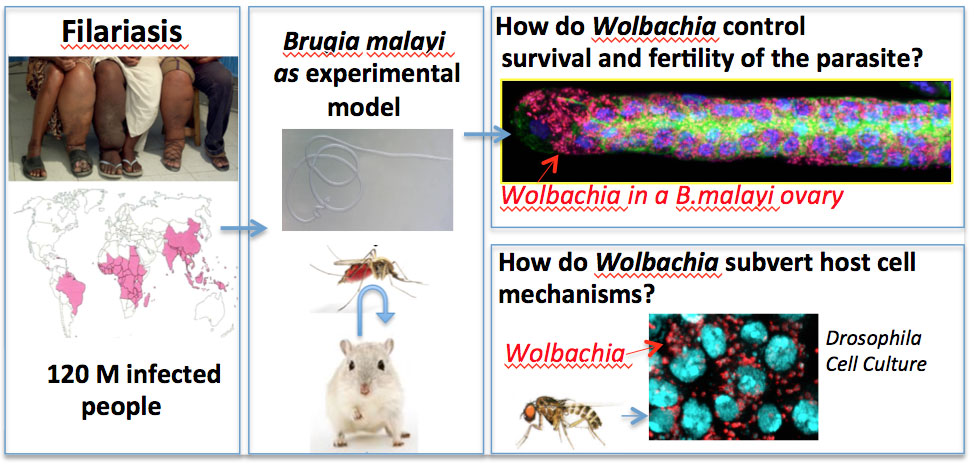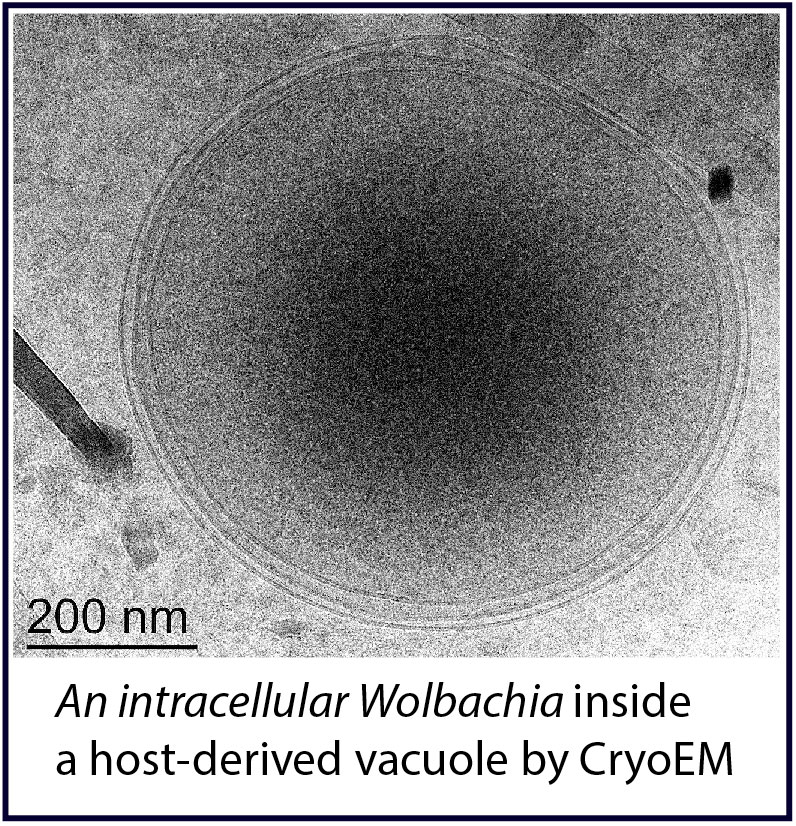
Our Research

From nematodes to insects…
Wolbachia are widespread bacteria in nature. They live in symbiosis with an amazing diversity of arthropod species, and are also hosted by parasitic filarial nematodes. These bacteria have the amazing peculiarity of being transmitted by the host female germ line to the offspring, like mitochondria. As Wolbachia can affect the biology of their hosts, which can be disease vectors (for instance, mosquitos or human parasites), they are of utmost biomedical relevance. Filariasis is a highly debilitating vector-borne disease that affects over 120 million people in tropical areas. It is caused by parasitic nematodes that live in mutualism with Wolbachia. Without their symbionts, these worms become sterile and quickly die. Therefore, Wolbachia is a promising drug target. We study the cellular and molecular mechanisms underlying the symbiosis with Wolbachia in nematodes and insects. To this aim, we develop new techniques of observation and investigation, especially for filarial nematodes.
 Outstanding questions:
Outstanding questions:
We use a multispecies approach to address key issues:
- What are the transmission mechanisms of Wolbachia, within an organism (from the zygote to the adult germline), and within an insect population?
- Why are Wolbachia required for the survival and fertility of the filarial species they colonize?
- How do Wolbachia subvert the host cell machinery to establish and maintain their intracellular lifestyle?
Models we use:
To address these questions, we use the natural hosts of Wolbachia as experimental models, such as Brugia malayi (the causative agent of elephantiasis) and other filarial nematodes species, as well as the Drosophila fly and the Culex pipens mosquito.
En savoir plus
Wolbachia et les parasites filaires.
Chez l’homme, les parasites filaires sont responsables de maladies tropicales négligées touchant plus de 120 millions d’individus, les filarde graves maladies handicapantes telles que  l’éléphantiasis (filariose lymphatique) ou la cécité des rivières (onchocercose). Les endosymbiotes Wolbachia sont nécessaires à la fécondité et la survie des adultes filaires, et ces mêmes bactéries jouent un rôle crucial dans le développement des pathologies lorsqu’elles sont libérées dans le corps humain pendant la dégradation des larves mortes. Aussi les Wolbachia sont-elles devenues de nouvelles cibles thérapeutiques dans la lutte contre ces parasites humains, aucun des traitements antiparasitaires disponibles ne venant à bout des formes adultes dont la durée de vie dépasse les 10 ans, et dont les femelles relarguent chaque jour des centaines de larves.
l’éléphantiasis (filariose lymphatique) ou la cécité des rivières (onchocercose). Les endosymbiotes Wolbachia sont nécessaires à la fécondité et la survie des adultes filaires, et ces mêmes bactéries jouent un rôle crucial dans le développement des pathologies lorsqu’elles sont libérées dans le corps humain pendant la dégradation des larves mortes. Aussi les Wolbachia sont-elles devenues de nouvelles cibles thérapeutiques dans la lutte contre ces parasites humains, aucun des traitements antiparasitaires disponibles ne venant à bout des formes adultes dont la durée de vie dépasse les 10 ans, et dont les femelles relarguent chaque jour des centaines de larves.
Pendant l’embryogenèse de Brugia malayi, un des agents responsable de l’éléphantiasis, les Wolbachia ségrégent asymétriquement dès la première division, pour envahir uniquement certains précurseurs de l’hypoderme. A partir de l’hypoderme de l’adulte juvénile, un tropisme ovarien permet la colonisation par Wolbachia des cellules germinales.
Nous étudions les bases cellulaires et moléculaires de cette transmission.
L’incompatibilité cytoplasmique.
Les Wolbachia peuvent être également naturellement présentes chez les mouches drosophiles et chez les moustiques. Dans les deux cas, elles ne sont pas essentielles à la survie de leur hôte, et donc en manipulent la reproduction afin d’assurer leur transmission. Par une complexe stratégie qui élimine la descendance des femelles non infectées fécondées par des males infectés (une voie sans issue pour des bactéries transmises maternellement), les femelles et leur descendances infectées se retrouvent avantagées. Cette stratégie appelée Incompatibilité Cytoplasmique (CI) est la plus communément employée par les Wolbachia pour envahir une population d’insectes.
femelles non infectées fécondées par des males infectés (une voie sans issue pour des bactéries transmises maternellement), les femelles et leur descendances infectées se retrouvent avantagées. Cette stratégie appelée Incompatibilité Cytoplasmique (CI) est la plus communément employée par les Wolbachia pour envahir une population d’insectes.
Au cours du CI, le sperme issu d’un male infecté par Wolbachia ne conduit pas à un développement normal après fécondation d’un œuf non infecté. Dès la première mitose zygotique, la chromatine paternelle qui présente des défauts de remodelage est incapable de se condenser et de ségréger normalement, conduisant à un développement aneuploïde ou haploïde létal chez la mouche comme le moustique.
Nous étudions les bases moléculaires du CI, afin de comprendre comment les Wolbachia modifient le sperme, et comment leur présence dans l’œuf restaure un développement normal.
Financements
ANR WOLF (01/10/2021 – 30/09/2025)
ANR CYTOTIKS (01/10/2025 – 30/09/2029)
Publications
2025
- Host environment shapes filarial parasite fitness and Wolbachia endosymbionts dynamics. Fercoq F, Cormerais C, Remion E, Gal J, Plisson J, Fall A, Alonso J, Lhermitte-Vallarino N, Hübner MP, Kohl L, Landmann F, Martin C. PLoS Pathog. 2025 Jul 11;21(7):e1013301. Pubmed
- Recombination, truncation and horizontal transfer shape the diversity of Wolbachia-induced cytoplasmic incompatibility patterns. Namias A, Martinez J, Boussou I, Terretaz K, Conner W, Justy F, Makoundou P, Perriat-Sanguinet M, Labbé P, Sicard M, Landmann F, Weill M. Mol Biol Evol. 2025 Aug 12:msaf200. Pubmed
2023
- Functional analysis of Wolbachia Cid effectors unravels cooperative interactions to target host chromatin during replication. Terretaz K, Horard B, Weill M, Loppin B, Landmann F. PLoS Pathog. 2023 Mar 16;19(3):e1011211. Pubmed
2022
- Paternal transmission of the Wolbachia CidB toxin underlies cytoplasmic incompatibility. Horard B, Terretaz K, Gosselin-Grenet AS, Sobry H, Sicard M, Landmann F, Loppin B. Curr Biol. 2022 Mar 28;32(6):1319-1331.e5. Pubmed
- A qPCR to quantify Wolbachia from few Onchocerca volvulus microfilariae as a surrogate for adult worm histology in clinical trials of antiwolbachial drugs. Schlabe S, Korir P, Lämmer C, Landmann F, Dubben B, Koschel M, Albers A, Debrah LB, Debrah AY, Hübner MP, Pfarr K, Klarmann-Schulz U, Hoerauf A. Parasitol Res. 2022 Jan 10. Epub ahead of print. Pubmed
2021
- Cytoplasmic Incompatibility Variations in Relation with Wolbachia cid Genes Divergence in Culex pipiens. Sicard M, Namias A, Perriat-Sanguinet M, Carron E, Unal S, Altinli M, Landmann F, Weill M. mBio. 12(1):e02797-20 Pubmed
- Dual RNAseq analyses at soma and germline levels reveal evolutionary innovations in the elephantiasis-agent Brugia malayi, and adaptation of its Wolbachia endosymbionts. Chevignon G, Foray V, Pérez-Jiménez MM, Libro S, Chung M, Foster JM, Landmann F. PLoS Negl Trop Dis. 15(1):e0008935 Pubmed
2019
- IL-4 receptor dependent expansion of lung CD169+ macrophages in microfilaria-driven inflammation. Fercoq F, Remion E, Frohberger SJ, Vallarino-Lhermitte N, Hoerauf A, Le Quesne J, Landmann F, Hübner MP, Carlin LM, Martin C. PLoS Negl Trop Dis ;13(8):e0007691 Pubmed
- Discovery of short-course antiwolbachial quinazolines for elimination of filarial worm infections. Bakowski MA, Shiroodi RK, Liu R, Olejniczak J, Yang B, Gagaring K, Guo H, White PM, Chappell L, Debec A, Landmann F, Dubben B, Lenz F, Struever D, Ehrens A, Frohberger SJ, Sjoberg H, Pionnier N, Murphy E, Archer J, Steven A, Chunda VC, Fombad FF, Chounna PW, Njouendou AJ, Metuge HM, Ndzeshang BL, Gandjui NV, Akumtoh DN, Kwenti TDB, Woods AK, Joseph SB, Hull MV, Xiong W, Kuhen KL, Taylor MJ, Wanji S, Turner JD, Hübner MP, Hoerauf A, Chatterjee AK, Roland J, Tremblay MS, Schultz PG, Sullivan W, Chu XJ, Petrassi HM, McNamara CW. Sci Transl Med ;11(491):eaav3523 Pubmed
- Wolbachia endosymbionts subvert the endoplasmic reticulum to acquire host membranes without triggering ER stress. Fattouh N, Cazevieille C, Landmann F. PLoS Negl Trop Dis. 13(3):e0007218. Pubmed
- The Wolbachia Endosymbionts. Landmann F. Microbiol Spectr. 7(2). Pubmed
2018
- The cellular phenotype of cytoplasmic incompatibility in Culex pipiens in the light of cidB diversity. Manon Bonneau, Frédéric Landmann, Pierrick Labbé, Fabienne Justy, Mylène Weill, Mathieu Sicard. PLoS Pathog; 14(10):e1007364. Pubmed
- Wolbachia Control Stem Cell Behavior and Stimulate Germline Proliferation in Filarial Nematodes. Foray V, Pérez-Jiménez MM, Fattouh N, Landmann F. Dev Cell. 45(2):198-211. Pubmed
2016
- Non-centrosomal epidermal microtubules act in parallel to LET-502/ROCK to promote C. elegans elongation. Quintin S, Wang S, Pontabry J, Bender A, Robin F, Hyenne V, Landmann F, Gally C, Oegema K, Labouesse M. Development. 143:160-73. Pubmed
2014
- Drosophila protamine-like Mst35Ba and Mst35Bb are required for proper sperm nuclear morphology but are dispensable for male fertility. Tirmarche S, Kimura S, Sapey-Triomphe L, Sullivan W, Landmann F, Loppin B. G3 (Bethesda). 4:2241-5. Pubmed
- Co-evolution between an endosymbiont and its nematode host: Wolbachia asymmetric posterior localization and AP polarity establishment. Landmann F, Foster JM, Michalski ML, Slatko BE, Sullivan W. PLoS Negl Trop Dis. 28:e3096. Pubmed
- Absence of Wolbachia endobacteria in the human parasitic nematode Dracunculus medinensis and two related Dracunculus species infecting wildlife. Foster JM, Landmann F, Ford L, Johnston KL, Elsasser SC, Schulte-Hostedde AI, Taylor MJ, Slatko BE. Parasit Vectors. 7:140. Pubmed
2013
- Interdomain lateral gene transfer of an essential ferrochelatase gene in human parasitic nematodes. Wu B, Novelli J, Jiang D, Dailey HA, Landmann F, Ford L, Taylor MJ, Carlow CK, Kumar S, Foster JM, Slatko BE. Proc Natl Acad Sci U S A. 110(19):7748-53. Pubmed
2012
- Efficient in vitro RNA interference and immunofluorescence-based phenotype analysis in a human parasitic nematode, Brugia malayi. Landmann F, Foster JM, Slatko BE, Sullivan W. Parasit Vectors. 5:16. Pubmed
- A cell-based screen reveals that the albendazole metabolite, albendazole sulfone, targets Wolbachia. Serbus LR, Landmann F, Bray WM, White PM, Ruybal J, Lokey RS, Debec A, Sullivan W. PLoS Pathog. 8(9):e1002922. Pubmed
- A new type F Wolbachia from Splendidofilariinae (Onchocercidae) supports the recent emergence of this supergroup. Lefoulon E, Gavotte L, Junker K, Barbuto M, Uni S, Landmann F, Laaksonen S, Saari S, Nikander S, de Souza Lima S, Casiraghi M, Bain O, Martin C. Int J Parasitol. 42(11):1025-36. Pubmed
- Both asymmetric mitotic segregation and cell-to-cell invasion are required for stable germline transmission of Wolbachia in filarial nematodes. Landmann F, Bain O, Martin C, Uni S, Taylor MJ, Sullivan W. Biol Open. 1(6):536-47. Pubmed
2011
- A tension-induced mechanotransduction pathway promotes epithelial morphogenesis. Zhang H, Landmann F, Zahreddine H, Rodriguez D, Koch M, Labouesse M. Nature. 471(7336):99-103. Pubmed
- New insights into the evolution of Wolbachia infections in filarial nematodes inferred from a large range of screened species. Ferri E, Bain O, Barbuto M, Martin C, Lo N, Uni S, Landmann F, Baccei SG, Guerrero R, de Souza Lima S, Bandi C, Wanji S, Diagne M, Casiraghi M. PLoS One. 6(6):e20843. Pubmed
- Anti-filarial activity of antibiotic therapy is due to extensive apoptosis after Wolbachia depletion from filarial nematodes. Landmann F, Voronin D, Sullivan W, Taylor MJ. PLoS Pathog. 7(11):e1002351. Pubmed
2010
- Asymmetric Wolbachia segregation during early Brugia malayi embryogenesis determines its distribution in adult host tissues. Landmann F, Foster JM, Slatko B, Sullivan W. PLoS Negl Trop Dis. 4(7):e758. Pubmed
2009
- Wolbachia-mediated cytoplasmic incompatibility is associated with impaired histone deposition in the male pronucleus. Landmann F, Orsi GA, Loppin B, Sullivan W. PLoS Pathog. 5(3):e1000343. Pubmed
- Myosin II regulation during C. elegans embryonic elongation: LET-502/ROCK, MRCK-1 and PAK-1, three kinases with different roles. Gally C, Wissler F, Zahreddine H, Quintin S, Landmann F, Labouesse M. Development. 136(18):3109-19. Pubmed
2008
- The genetics and cell biology of Wolbachia-host interactions. Serbus LR, Casper-Lindley C, Landmann F, Sullivan W. Annu Rev Genet. 42:683-707. Pubmed
Mechanisms of symbiosis with Wolbachia

Frédéric Landmann
Group Leader (Research Director CNRS)
Team Members
(Chercheur DR2) +33 (0)4 34 35 95 65 |
|
(IE-Recherche) +33 (0)4 34 35 95 66 |

Contact us
Replace the name and address below with that of the member to contact
firstname.name@crbm.cnrs.fr











